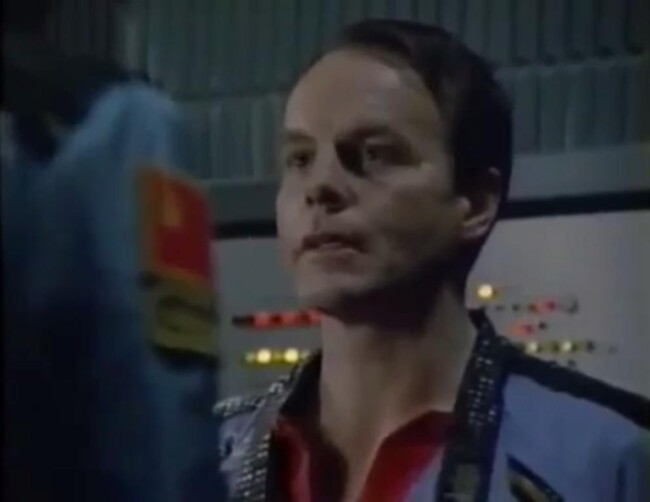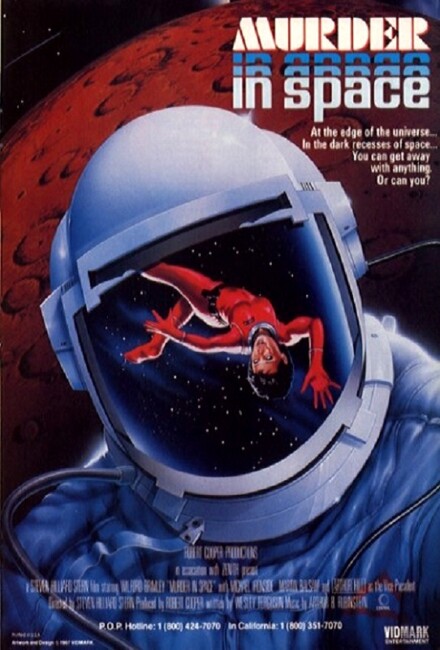aka Whodunit? Murder in Space
Canada. 1985.
Crew
Director – Steven Hilliard Stern, Teleplay – Wesley Ferguson, Producer – Robert Cooper, Photography – Laszlo George, Music – Arthur B. Rubinstein, Visual Effects – Quicksilver FX/Studio, Art Direction – Trevor Williams. Production Company – Robert Cooper/Zenith/CTV Television Network.
Cast
Wilford Brimley (Dr Andrew McAllister), Michael Ironside (Captain Neal Braddock), Martin Balsam (Alexander Rostov), Damir Andrei (Colonel Alexander Kalsinov), Wendy Crewson (Irene Tremayne), Nerene Virgin (Dr Margaret Leigh), Leo Ilial (Dr Philippe Berdoux), Alberta Watson (Dominica Mastrelli), Tom Butler (Major Kurt Steiner), Scot Denton (David Tremayne), Peter Dvorsky (Mitch Carlino), Arthur Hill (The Vice President), Timothy Webber (Guy Sterling), Jan Rubes (Gregory Danarenko), Cathie Shirriff (Olga Denarenko), Kate Trotter (Pamela Cooper)
Plot
Communication has been lost with the Conestoga spacelab, a multi-national expedition to Mars, during its return journey. Communications are re-established just as the Conestoga nears Earth. One of the crew Olga Denarenko, the wife of a Soviet minister, is then found dead. As Mission Controller Andrew McAllister orders an examination and autopsy to be conducted by the crew, it comes out that Denarenko was strangled and that she was two months pregnant. There is a determination to find the killer before the crew return to Earth but the murder has created strained tension between NASA and the Soviet authorities. As the investigation continues, there are further murders aboard the Conestoga.
Murder in Space was a Canadian-made TV Movie. The film came with a unique selling point where it was broadcast around the world without an ending. This was then followed by a panel of people discussing it where viewers were invited to write in with their speculations as to who the murderer was. A prize was offered ($60,000 when the film first aired on Showtime in the US, different sums in other countries). A special that contained the last fifteen minutes where the killer(s) are revealed was aired one week later.
Even aside from the novelty whodunit format, the premise of ‘murder on a NASA mission’ was a unique selling point for me. Unfortunately, Murder in Space is a case where writer Wesley Ferguson has done little to study his murder mystery predecessors – the Agatha Christies, the Arthur Conan Doyles, the Raymond Chandlers etc. The virtue of a good murder mystery is assembling a range of suspects, all of whom has strong motivation and yet equally plausible reasons why they cannot be the suspect. Here the range of characters is frequently faceless – the suspects (the crew on the Conestoga) are introduced at the start with a series of photos listing their names and professions. Subsequently though, some of these characters only have one or two lines of dialogue. This seems ridiculous in terms of trying to create a good mystery – half the film’s running time you spend trying to work out who is who and to remember back and connect them back to the character profile at the start.
The other drawback is that only part of Murder in Space – not even a half of it – is actually set aboard the spaceship. Instead, most of the story takes place on Earth and is involved in the political goings-on between the US (presumably NASA although it is never mentioned as such) and the Soviet authorities, even among the wives of mission crews, as well as some scenes that take place in the Soviet Union.

The eventual denouement as to what was going on among the multiple murders is absurdly complicated. Perhaps in order to cheat and not have to pay out on the promised reward for guessing who the killer was, the filmmakers have created a revelation that rivals Agatha Christie’s Murder on the Orient Express (1934) where everybody turned out to be the murderer. Here we get multiple murders in an excessively byzantine explanation that manages to involve poisons, KGB spies, gay love affairs, straight love affairs and a pregnancy, blackmail and vigilante justice – all going on amongst a crew of nine people! Certainly, the film does have characters on the mission engaged in a gay relationship some time before depiction of such was commonplace on screens.
Murder in Space is also disappointing in terms of a realistic depiction of NASA and the Space Program. The Conestoga ship appears to have magic anti-gravity – people move about as though in a regular Earth environment – although the ship is not even rotating in the exterior shots we get of it. We get a control room set but the rest of the ship is often depicted as being separated by no more than hanging plastic sheets.
Steven Hilliard Stern was a Canadian director with a career that lasted between the 1970s and 1990s. The majority of his work was in tv, although he did make the Disney film The Devil and Max Devlin (1981) featuring Bill Cosby as The Devil and the psycho film Rolling Vengeance (1987). His other genre work includes the tv movies The Ghost of Flight 401 (1978) and Mazes and Monsters (1982).
Trailer here
Full film available here


